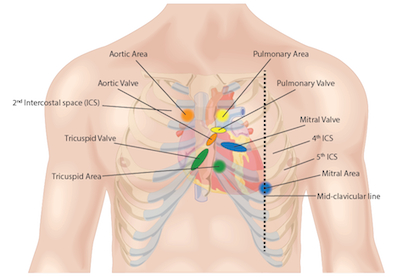Exploración cardiovascular II: Auscultación
Visión general
Fuente: Contactar Dhand, MD, médico, medicina interna, Beth Israel Deaconess Medical Center de asistir
Competencia en el uso de un estetoscopio para escuchar sonidos de corazón y la capacidad de diferenciar entre ruidos cardíacos normales y anormales son habilidades esenciales para cualquier médico. Colocación correcta del estetoscopio en el pecho se corresponde con el sonido de las válvulas cardiacas que se cierre. El corazón tiene dos sonidos principales: S1 y S2. El primer sonido de corazón (S1) se produce como la válvula mitral y tricúspide (válvulas auriculoventriculares) cierre después de sangre entra en los ventrículos. Esto representa el comienzo de la sístole. El segundo sonido de corazón (S2) se produce cuando se cierran las válvulas aórticas y pulmonares (válvulas semilunares) después de sangre ha dejado a los ventrículos para entrar en los sistemas de circulación sistémica y pulmonar al final de la sístole. Tradicionalmente, los sonidos se conocen como un "lub-dub".
Auscultación del corazón se realiza con diafragma y campana de partes de la pieza de pecho de estetoscopio. El diafragma es más comúnmente utilizado y es el mejor para sonidos de alta frecuencia (como S1 y S2) y soplos de regurgitación mitral y estenosis aórtica. El diafragma debe presionarse firmemente contra la pared de pecho. La campana mejor transmite sonidos de baja frecuencia (por ejemplo, S3 y S4) y el soplo de la estenosis mitral. La campana debe aplicarse con una ligera presión.
Procedimiento
1. Coloque al paciente en 30-45 grados.
2. Asegúrese de que el área examinado está expuesta y nunca auscultar a través del vestido.
3. colocar el estetoscopio en los puntos anatómicos definidos (figura 1). Una buena regla para encontrar el segundo espacio intercostal es localizar el ángulo de Louis (articulación costovertebral), que es a este nivel. Palpar a través y hacia abajo con los dedos para localizar los otros espacios intercostales descritos
Aplicación y resumen
Auscultación del corazón sigue siendo una de las habilidades fundamentales para cualquier clínico a maestro, y proporciona pistas de diagnóstico vitales a muchas anormalidades cardiacas. Aprender la técnica correcta para la auscultación es esencial para distinguir lo normal de lo patológico. Todas las áreas cardiacas se deben auscultar de manera estructurada y metódica. Los resultados físicos deben interpretarse en relación con el ciclo cardíaco, y cabe destacar la intensidad, duración, tono y tiempo de cada...
Saltar a...
Vídeos de esta colección:

Now Playing
Exploración cardiovascular II: Auscultación
Physical Examinations I
140.1K Vistas

Abordaje general para la exploración física
Physical Examinations I
117.6K Vistas

Observación e inspección
Physical Examinations I
95.0K Vistas

Palpación
Physical Examinations I
84.5K Vistas

Percusión
Physical Examinations I
101.7K Vistas

Auscultación
Physical Examinations I
62.2K Vistas

Ajuste adecuado de la vestimenta del paciente durante el exploración física
Physical Examinations I
83.4K Vistas

Medición de la presión arterial
Physical Examinations I
108.8K Vistas

Medición de los signos vitales
Physical Examinations I
114.9K Vistas

Exploración pulmonar I: inspección y palpación
Physical Examinations I
157.3K Vistas

Exploración pulmonar II: Percusión y auscultació
Physical Examinations I
212.9K Vistas

Exploración cardiovascular I: Inspección y palpación
Physical Examinations I
176.6K Vistas

Exploración cardiovascular III: Ruidos cardíacos anormales
Physical Examinations I
91.9K Vistas

Exploración vascular periférica
Physical Examinations I
68.8K Vistas

Exploración vascular periférica con un Doppler de onda continua
Physical Examinations I
38.6K Vistas
ACERCA DE JoVE
Copyright © 2025 MyJoVE Corporation. Todos los derechos reservados
